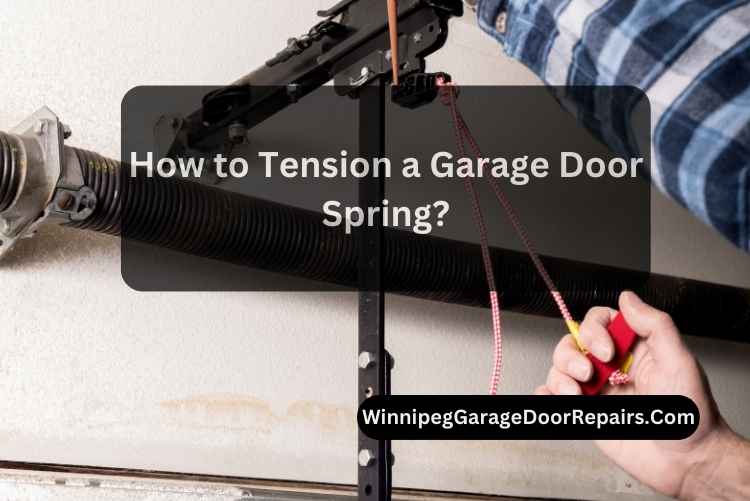Is your garage door not opening as smoothly as it used to in Winnipeg? This might be a sign that the tension in your garage door torsion springs Winnipeg needs adjustment. Properly tensioned springs are crucial for the smooth operation and longevity of your garage door. This guide will walk you through understanding the different types of garage door springs, including the torsion spring, which is quite common in Winnipeg homes, how to safely adjust their tension, and when it’s time to call in the professionals. Whether you’re dealing with a torsion spring or any other type, we’ll dive in and get your garage door working like new again!
Types of Tension a Garage Door Spring
- Torsion Springs: These springs are mounted above the garage door opening and use torque to lift and lower the door. They are known for their efficiency and durability, making them a popular choice for heavier doors.
- Extension Springs: These are located on either side of the door and extend when the door is moved. Extension springs are typically used for lighter doors and are considered more cost-effective but can require more maintenance.
Tensioning Torsion Springs
Adjusting the tension on torsion springs is a critical process that involves several steps to ensure safety and effectiveness, often leading to the need to replace garage door springs. This procedure becomes especially pertinent with concerns about the garage door spring color code, as it can significantly impact the balance and functionality of the garage door. Properly addressing this issue not only involves understanding the color code but also carefully recalibrating the tension of the torsion springs to restore the door’s smooth operation. Replacing worn or incorrect springs is essential in this context to maintain the equilibrium and efficiency of the garage system. Ensuring these components are correctly adjusted and replaced when necessary is crucial for maintaining the longevity and safety of your garage door system.
- Secure the Garage Door: Close the door and disconnect the opener to prevent it from activating during adjustment. Use C-clamps or locking pliers on the tracks just above the bottom rollers to prevent the door from opening.
- Loosen the Set Screws: Locate the winding cone at the end of the spring. Insert a winding bar into the bottom hole of the winding cone and hold it firmly. Use a wrench to loosen the set screws on the cone.
- Adjust the Tension: With one winding bar in place, insert a second bar into the next hole. Carefully remove the first bar and turn the cone with the second bar to adjust the tension. For increasing tension, wind the spring up; to decrease tension, unwind it slightly.
- Secure the Adjustment: Once the desired tension is achieved, hold the winding bar in place and tighten the set screws on the winding cone. Ensure they are tight to prevent the spring from unwinding.
- Test the Door: Carefully remove the clamps and manually lift the door halfway. If properly balanced, the door should stay in place without assistance.
Tensioning Extension Springs
Extension springs require a different approach due to their design and placement:
- Open the Garage Door: Fully open the door to reduce tension on the springs. Secure the door in place using C-clamps or locking pliers on the tracks.
- Disconnect the Spring: Unhook the spring from the track support and the pulley system.
- Adjust the Cable: Adjust the length of the cable to change the tension on the spring. This may involve moving the S-hook or adjusting the clamp on the cable.
- Reattach and Test: Once adjusted, reattach the spring to the pulley system and track support. Remove the clamps and test the door’s balance by opening and closing it manually.
When to Call a Professional?
While minor adjustments can be safely made by a homeowner with the right tools and knowledge, there are situations, such as when a garage door spring breaks, when calling a professional is the best course of action. This event is crucial for identifying the need for correct spring tension for your garage door, ensuring it operates safely and efficiently. Without proper knowledge of how to handle such a breakage, attempting to replace or adjust a garage door spring can be dangerous. Therefore, in cases involving the garage door’s mechanical components, especially the springs, it’s advisable to seek the expertise of a trained technician.
- Spring Replacement: If a spring is broken, it must be replaced rather than adjusted. This task is dangerous and requires professional tools and expertise.
- Significant Adjustments: Major adjustments or rebalancing of the door should be performed by professionals to ensure safety and proper operation.
- Safety Concerns: If you’re uncomfortable with the process or unsure about the correct adjustments, it’s safer to hire a professional. They have the experience and equipment to safely make adjustments.
Conclusion
Adjusting the tension on your garage door springs can significantly improve the operation and lifespan of your door. Whether you’re dealing with torsion or extension springs, it’s crucial to approach the task with caution and prioritize safety. For major adjustments, replacements, or if you’re unsure, always opt to call a professional. Proper maintenance and timely adjustments can keep your garage door running smoothly and safely for years to come.







